The outbreak of novel Coronavirus across the globe, which affected lives of millions of people continues to take its toll on the global economies. With more than 7-8 months into the crisis the virus is still omnipresent. It forced countries to adopt control measures like lockdown, curfew, social distancing, masks etc. As a result of which many countries have been successful in curbing the rate of spread and have also moved past the peak in terms of maximum confirmed cases reported.
How should one define peak?
Calculating the peak may become a very cumbersome task requiring statistical analysis, rather a look into the numbers alone could also help us understand the trends. The most important metric in this regard is the number of reported cases on a daily frequency. The cases reported usually follows a bell curve pattern, in which the count begins to increase to reach a peak before it begins to decline. It is also important to check if the recovery rates are improving, as a situation wherein recovery rate begins to drop could indicate that a possibility of a resurgence exists.
7 months into the crisis how have countries fared?
Many countries appear to have past their peak. The below chart helps understand about the peak attained by respective countries. The USA being the worst affected economy attained its peak on 16th July, wherein a country like India is which is also reopening its economy and businesses is moving within a range very close to the current identified peak. Singapore on the other hand has managed the situation quite well, although after the initial success, it also had its share of issues with the case hike particularly reported in labour camp.
Ad: Marmore Research Report
Reported Peaks by countries
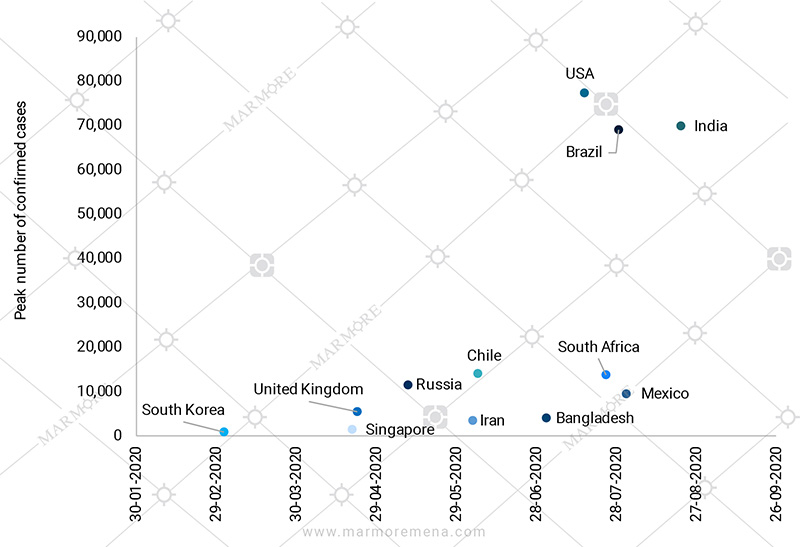 Source: Johns Hopkins University, Marmore Analysis
Source: Johns Hopkins University, Marmore Analysis
Daily confirmed cases trends:
Post attaining peak most of the countries current reported numbers are down by 50% and more, except India and Iran. Higher the drop reported better it is. In case of Singapore, Chile and South Africa the current numbers are more than 80% below the peak levels.
Peak vs current reported cases (daily)
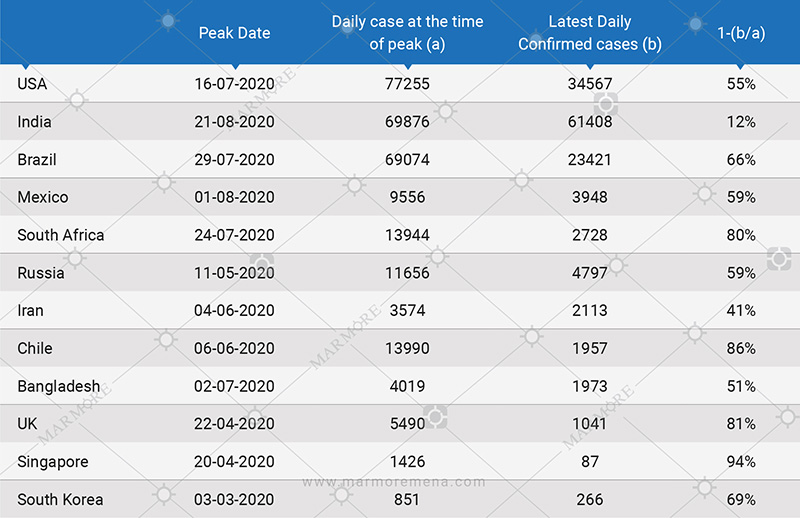
Source: Johns Hopkins University, Marmore Analysis Note: Latest daily cases is as of 23rd August 2020
Did You Know?Recovery trends:
Most of the countries have seen a substantial improvement in the recovery rates compared to the peak period. Notable examples are Singapore which moved from 10% recovery to 96.1% recovery rate and South Korea which moved from mere 0.6% to 80.5%. Russia, South Africa, Chile have also shown good improvements. Countries which have crossed 80%+ recovery rates are better positioned to manage future spikes if any, as higher recovery rate entails less burden on the healthcare infrastructure. Better healthcare in turn is instrumental in curbing death rates, as critical patients are able to get the necessary aid on time.
Recovery rate peak vs latest
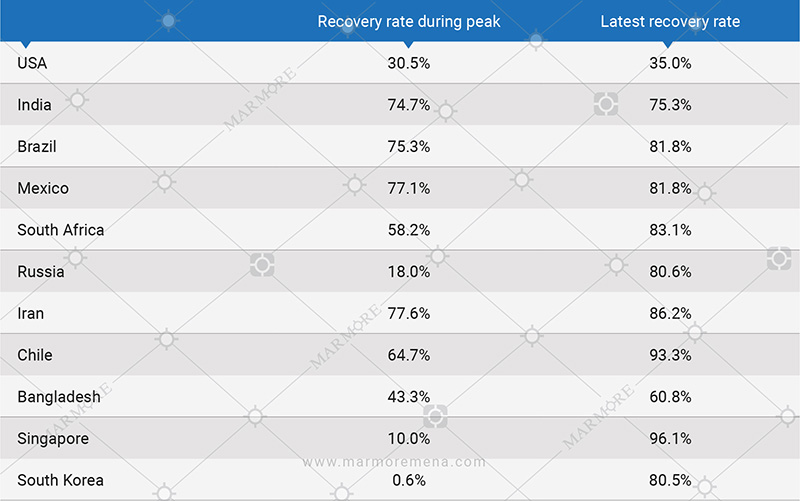
Source: Johns Hopkins University, Marmore Analysis Note: Latest recovery rate is as of 23rd August 2020
Has GCC countries reached their peaks?
GCC countries were quick to react to COVID-19 threat and had imposed very strict restrictions on mobility. Certainly this has helped the region navigate through a difficult phase and begin to re-open the economy. Depending on the measures taken at varying timelines each country has reached a peak at different time points.
7 Days moving average of daily confirmed cases (scaled at 100)
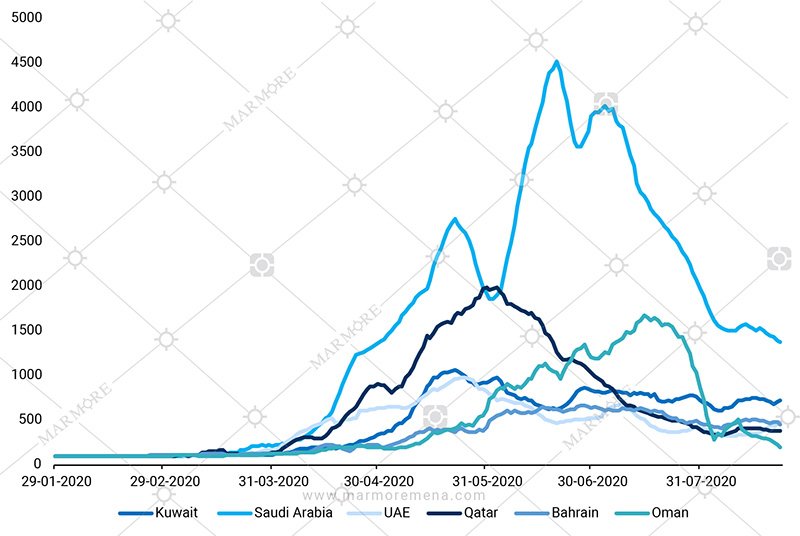
Source: Johns Hopkins University, Marmore Analysis
Among GCC Countries Oman and Qatar are currently reporting cases which are lower by more than the 80% mark, signalling the worst may be over. Saudi Arabia has also seen good improvement over the period. Bahrain, UAE and Kuwait are also reporting lower cases than the peak, but the drop is not as significant as in the case of other countries in the GCC region.. Kuwait in particular has been reporting flat numbers, with very mild variation.
Peak vs current reported cases (daily)
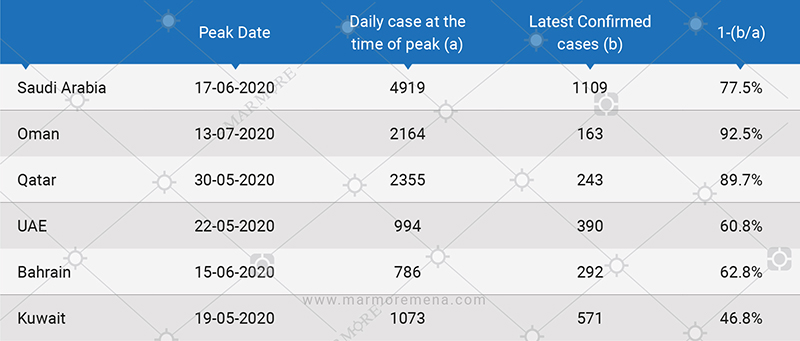 Source: Johns Hopkins University, Marmore Analysis
Note: Latest daily cases is as of 23rd August 2020
Source: Johns Hopkins University, Marmore Analysis
Note: Latest daily cases is as of 23rd August 2020
Recovery trends for the GCC countries:
Except Kuwait most of the GCC Countries were above 45% of recovery rate at the time of peak. This improved substantially in the current period as all the GCC countries are having phenomenal recovery rates of above 85%. This clearly indicates that for future spikes GCC countries are well prepared to respond.
Recovery rate peak vs latest
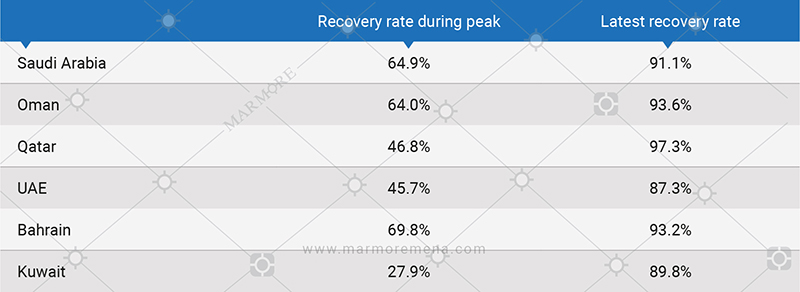
Source: Johns Hopkins University, Marmore Analysis Note: Latest daily cases is as of 23rd August 2020
In summary GCC Countries looks to have weathered the current storm.. However, with Dubai opening up for tourists, Kuwait entering its 4th phase of reopening and similar opening up of economies might pose a challenge to manage.
Does reaching the peak mean the worst is over?
Not necessarily, Australia, Japan and South Korea have all seen the emergence of the so called ‘second wave’.
7 Days moving average of daily confirmed cases (scaled at 100)
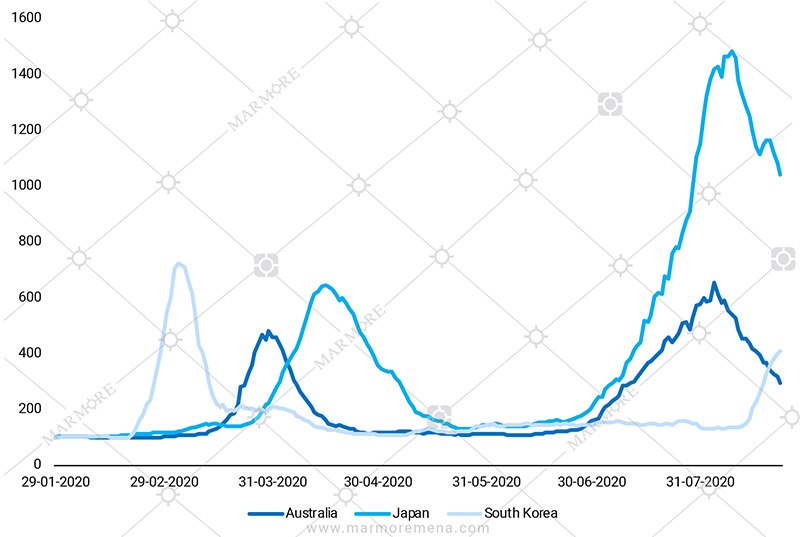
Source: Johns Hopkins University, Marmore Analysis
Even China has been very aggressively attempting to contain the emergence of the second wave as it resorts to extensive testing and subsequent measures in any new cluster posing a threat of re-emergence. Re-opening of economies to sustain livelihood has also brought back the risk of a second wave. Development of vaccine or herd immunity are the only two viable options to weather this challenge. There are very good progress being made on the vaccine development front but the wait is still on for a long term solution. 
Ad: Marmore Research Report
Stay Tuned To Marmore MENA Insights!
Never miss a patch or an update with Marmore's Newsletter. Subscribe now!
Related Article
The uptick in MENA Eurobond issuances – A sign of things to come?
MENA debt issuances have touched record highs in Q1 2025. Will the uptick continue in subsequent quarters?
Read MoreKuwait’s Approval of Public Debt Law: Re-emerging on Investors’ Radar
Kuwait has passed the long-awaited debt law in March 2025. The blog explores the importance of the law, the expected benefits and outlook for the countrys return to debt markets.
Read MoreThe Dynamic Rise of Fintech in the GCC
The convergence of technology and finance is reshaping the GCC Financial Ecosystem. The blog explores key players, regulatory framework and market dynamics of Fintech in the GCC region.
Read More





